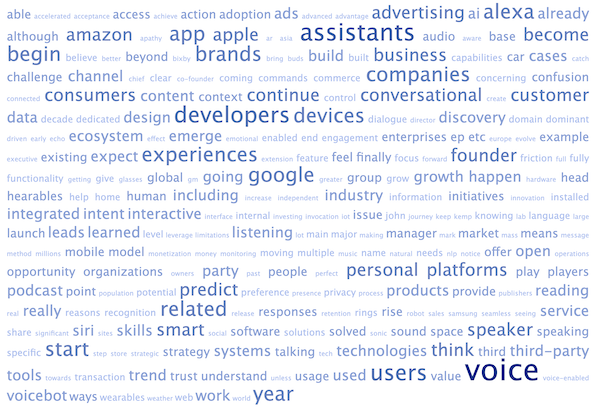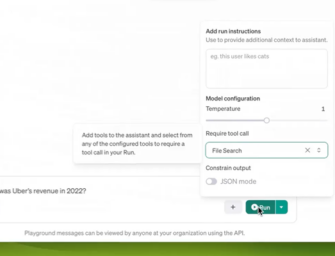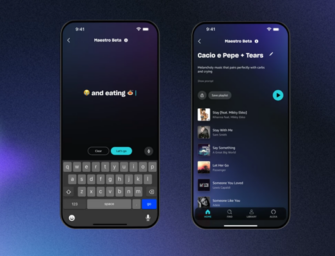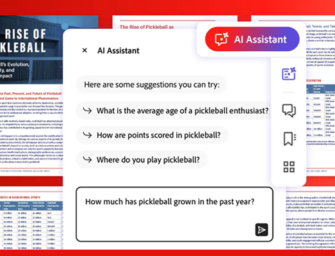Voice AI 2020 Predictions from 46 Voice Industry Pros

Today we start a new year and a new decade. The past decade has in many ways been about the dominance of mobile followed by the rise of voice assistants. The decade started with the launch of the Siri app in the iOS App Store and concluded with more than three billion voice assistants in use worldwide.
What is ahead of us for the first year of the second decade of voice assistants? Voicebot reached out to over 40 voice industry professionals to get their predictions for 2020. They range from the rise of sonic branding and new architectures for voice assistants to the increasing importance of hearables and voice in the car. There are also predictions about the first hundred million dollar voice apps.
There is a lot of depth in here with so many experts weighing in. So, in the spirit of TLDR, we have included a word cloud of the responses below.

Voice Strategy Predictions
David Cicarelli, CEO, Voices.com
In 2020 we’ll see more and more brands incorporating sonic branding into their overall marketing strategies, with Alexa Skills and Google Actions becoming more popular. It will be interesting to see how companies will build brand trust with voice technologies that aren’t quite fully trusted yet, and I predict that the use of the human voice will be a big factor in building that trust. Not only is there a preference for human voices in voice technology, but a human voice also increases information retention.
Related reading: Consumers Have 71% Preference for Human Over Robot Voices

Katie McMahon, SoundHound
Katie McMahon, General Manager, SoundHound
The love affair we have with hardware design will migrate to a love affair of Voice Interface Design. Although I doubt “a Jony Ive of Voice” will emerge within 2020, I predict that by the end of this decade, we will know the names of a few revered VUI designers. It will be those who can design the future by understanding both its current technical limitations and trajectory while harnessing anthropological, sociological, and humanity-first guiding principles.
Related reading: Voice UX Best Practices eBook – Over 100 Insights from 17 Experts
Pete Erickson, CEO, Modev
There will be more surprising acquisitions in 2020 similar to Apple’s acquisition of Pullstring and as a handful of B2B enabling platforms breakout of the pack. Look to Amazon, Google, Salesforce, Apple, Adobe and others to compete for technology and talent. I think we’ll see a major retailer make a big play in voice in 2020 and I wouldn’t be surprised to see custom naming for devices hit one of the big two (you know who they are) in a future release. And, of course, VOICE Summit will be a blast. 🙂
Related reading: Apple Acquires Pullstring as Voicebot Insider First Reported
Roger Kibbe, Senior Developer Evangelist, Viv Labs/Samsung
In 2020, having a voice presence will start to be a strategic and business differentiator for companies. We are moving beyond voice as a side innovation project to it being a first-class citizen on the same level as social, mobile and web. Companies who have or will soon establish a voice presence will start to reap the business benefits over laggards, much like what happened with the web and mobile.
Related reading: How to Build a Samsung Bixby Capsule
Jason Fields, Chief Strategy Officer, Voicify
It feels like the voice groundswell is approaching land and executives can begin to see the shape of the conversational experience wave. This in concert with other developments like the maturity of voice assistants, the emergence of voice commerce as a real topic, and a growing ecosystem voice solutions and agencies leads me to believe that 2020 is going to see a noticeable increase of formal voice strategy and inclusion in customer journey maps.
Related listening: Jeff McMahon Talks About Voicify and the Martech Stack – Voicebot Podcast Ep 125
Voice Search and Discovery Predictions
Beth Strohbusch, SVP Strategic Communications, Orbita
A focus on voice search will dominate in 2020. Organizations will seek new opportunities to tap the power of virtual assistants and conversational AI – to help consumers to discover and engage more fully with their brands through next-generation SEO and conversational calls to action.
Related reading: New Data on Voice Assistant SEO a Wake-up Call for Brands
Mark Phillips, Managing Partner, SimpliSpoken
Discoverability is the key issue holding the ecosystem back from realizing the potential that voice experiences offer. Even with the encouraging market penetration of voice platforms, consumers are for the most part unaware of what voice can do. I do not believe voice platform vendors, voice experience developers, or businesses can solve this problem in isolation. I predict an independent third party will attack this issue with a platform that brings together consumers, vendors, developers, and businesses to provide shared value and incentives to cross the chasm.
Related reading: 34 Percent of Marketers Expect to Have a Voice App by 2020
Mark Tucker, Senior Architect, Soar
Key areas of concern for voice apps on assistants are convenience, context, memory, personalization, monetization, retention, and discoverability. With millions of owners of smart speakers, 2020 will be the year that a significant advancement will be made in discoverability and these owners will start consuming these voice apps.
Related reading: Alexa Conversations to Make Skill Building Easier and Boost Discovery
Matt Ware, Head of Operations, First
First, the main challenge to 3rd Party developers and also to brands is the challenge of discovery. How do consumers become aware of their Action, Skill, Capsule (or whatever other non-specific name other companies decide to call what is really a voice app)? Until this gets solved and solved consistently, we won’t see mass adoption of the medium by big players.

Matt Ware, First
As much as the onus does sit with these brands to self promote, Google, Amazon and Co need to pick a path and stick with it. Consumers have become used to having the right tool put in front of them at the right time. Implicit Invocation was the obvious path to continue this trend. However, that seems to be getting wound back in favor of “recommendation at signup” or fulfillment of the required task without the user knowing which Skill or Action did the heavy lifting. This year Discovery will be a focus for the ecosystem owners as they try to find a way to achieve the balance between wanting to own the whole user experience 1st Party and needing 3rd Party information and functions to actually deliver the service or item.
Second, Asia pulls away from the US and Europe with Voice. Asia is already seeing explosive growth in Smart Speaker shipments and development across the three main players (Xiaomi, Baidu and Alibaba). Population, funding, acceptance of digital payments and a friendly government environment will see this growth continue along with their dominance. The main battlegrounds will be South East Asia, India, Africa, and Australia. In all of these locations, there is less opposition to Asian technologies and large existing ex-pat Chinese populations happy to bring their preferred assistant of choice with them. While there is still the opportunity for growth in the U.S. and Europe, it’s Asia where there is money to be made.
Related reading: Smart Speaker Sales Rise 35% Globally, 15 Million in China
Voice Assistant Architecture

Tim McElreath, Discovery Inc
Tim McElreath, Director of Technology for Emerging Platforms, Discovery, Inc.
The “de-app-ification” of Alexa skills and Assistant agents. This year there is going to be a blurring of boundaries between third-party development, content presented in first-party platform templates, cross-linking between smaller related features, and a move toward shared (but extensible) domain language models.
Related listening: Tim McElreath of Food Network / Discovery Inc Talks Multimodal Design – Voicebot Podcast Ep 28
Giulio Caperdoni, Head of Innovation, Videmme
Assistants will move from intent classification and named-entity recognition, which is a manual and rigid process, and they will become more sophisticated, learning from examples and moving past the limitations imposed by mapping every message to one intent. The representation of state and context will be learned from the data itself, letting the users teach the assistants things that were not anticipated and making the assistants able to understand and respond to unexpected inputs.
Related listening: Adam Cheyer on 25 Years Building Voice Assistants – Voicebot Podcast Ep 109
Braden Ream, CEO, Voiceflow
We’re going to see the rise of intent-less voice app structures that will make transactional use cases, like voice commerce, far more effective.
Related listening: Braden Ream, CEO of Voiceflow – Voicebot Podcast Ep 112
John Kelvie, CEO/Founder, Bespoken
The rise of a new domain-centric development model for third-parties. The initial wave of voice was based around an app-centric model. This made sense, as the analogies and onramps for developers coming from mobile and web were so easy to make. But domains make more sense for users. Domains are top-level intents with third-party fulfillment. It also means that users are defining functional boundaries, not developers or product designers. Finally, it means discovery is moot. Forget about tricks and gambits to make users memorize and chant invocation names. Instead, builders must discover users where they are, in users’ natural expressions and requests.
To effect this expeditiously, the platforms must provide a way to bring third-parties in on top-level intents fairly and transparently. And third-parties must take users as they come – with a myriad of queries and commands that may not fit neatly into their existing app-centric way of thinking.
Related reading: Amazon to Roll Out Cross-skill Goal Completion
Miguel Berger, CEO, Voiceter Pro
In 2020, voice assistants will start to perfect the invocationless open of an app. This will happen because once Samsung fully releases Bixby, it will start to gain popularity and will spread to the other platforms. Voices will also start to sound more human. It is clear that people respond better to a less robotic a voice. It follows that the engineers at Samsung, Amazon and Google would focus energy on that.
Related reading: Speech Synthesis Becomes More Humanlike
Voice App Development and Monetization

Tom Hewitson, Labworks.io
Tom Hewitson, Founder, Labworks.io
2020 will be the year that the voice app ecosystem starts to make significant money. A combination of improved tools from the platforms and a greater focus on creating real value by developers will finally convince consumers to start parting with their hard-earned cash. We’re unlikely to see the first voice app unicorn in the next 12 months but perhaps we’ll spot a couple of multi-hundred hoof-prints pointing the way.
Related listening: 10 Hot Takes from Two-and-a-Half Years in Voice – Voicebot Podcast Ep 124
Bradley Metrock, CEO, Score Publishing
Competition will tighten among major tech companies for developer attention, leading to heightened investment and accelerated feature development over the course of 2020 for Alexa, Google Assistant, Bixby, and Siri.
Related reading: Bradley Metrock Offers 200 Alexa Uses That Aren’t Weather and Music in New Book
Charles Cadbury, CEO, Say-it-Now
The continued rise of voice commerce, specifically non-obvious ways voice removes pinch points in the customer journey. Voice commerce doesn’t always have to be at the last mile of the transaction but can have a very valuable part to play in the customer decision journey influencing the transaction.
Related reading: Adobe Says 45% of Businesses Investing in Voice List Voice Commerce as Top Priority
Arte Merrit, CEO/Co-Founder, Dashbot
As with any new channel, user acquisition, discovery, and monetization can be challenges. For Voice Assistants to continue to take off, and more users and enterprises to adopt them, I am hopeful the ecosystem continues to evolve and more opportunities for user acquisition, discovery and monetization come forward. As the ecosystem evolves, and enterprises see the value in Voice Assistants, hopefully, more initiatives move from innovation teams to business units in the coming year. We are still relatively early in the space and it is exciting to see the new use cases that emerge.
Related reading: Amazon Brings Skill Monetization to the UK and Germany
Voice Assistants on the Edge
Todd Mozer, CEO, Sensory
The rise of Domain Specific Voice Assistants. Products will start having natural language voice assistants on board, without privacy concerns or internet connections. Chip companies will announce a number of AI chips that support this at a cost that can be used in IoT, home appliances, and other consumer products.
Related reading: Sensory Debuts New Smart Appliance Voice Assistant Platform

Carl Robinson, Voice Tech Podcast
Carl Robinson, Host, Voice Tech Podcast
Voice AI on the edge for low-resourced IoT devices will come to the fore, with many more devices avoiding the cloud for both privacy and performance reasons. In addition, biometric authentication and emotion recognition will transform how we use voice assistants. We can look forward to using any smart speaker in the world with reduced friction and more relevant responses.
Apple will also launch some kind of voice skills, but they will be over-regulated and limited in performance. Unfortunately, Apple will continue to lag behind the other platforms. Hearables and voice-enabled wearables will be the catalyst for much greater usage and a wider variety of use cases, as mobile is inherently hands-free. Phone-zombies may even start to disappear!
Related reading: Dedicated Audio Processors on the Edge Are the Future. Here’s Why.
Voice in the Car
Pat Higbie, Co-Founder and CEO, XAPPmedia
The availability of Alexa and Google Assistant tightly integrated into fully connected vehicles will begin to achieve critical mass in 2020 and will accelerate the use of voice assistants by the masses. The writing is on the wall and all stakeholders including car manufacturers, voice assistant platforms, radio broadcasters, streaming services, and brands will need a conversational AI strategy in order to win in this paradigm shift.
Related reading: GM to Provide First Alexa Auto Implementation
Steve Tingiris, Chief Dabbler, Dabble Labs
Despite some predictions of a slowdown, the average daily usages of voice assistants will grow considerably more in 2020 than any previous year. This will be largely driven by the use of devices in automobiles and wearables – mostly earbuds.
Related reading: IDC Says Hearables Now the Biggest Wearable Category
Mauro del Rio, Founder, Solo.fm
Assistants widespread in cars.
Related reading: A Voice Giant is Born. Cerence Now Houses All of Nuance Automotive’s Solutions and Customers
Voice Assistants and Wearables / Hearables and Other Devices
Stuart Crane, Founder/CEO, Voice Metrics
One of the breakout hits in the voice space for 2020 and beyond will be voice-activated rings, starting with the Echo Loop. Alexa users will appreciate the ability to use Alexa anytime, anywhere without having to have a smart speaker nearby, or headphones in their ears. I predict that in 2020, Apple will take notice of this new “category” (voice-activated rings), and begin developing a Siri-compatible ring, which, sometime after 2020, will become an even bigger hit than the Echo Loop.
Related reading: Amazon Unveils Alexa-Powered Smart Glasses, Smart Ring
Max Child, Co-Founder, Volley
The tipping point for smart displays has come to pass. By the end of 2020, the most highly-used voice apps (outside of sleep) will include robust, stimulating visual experiences.
Related reading: Amazon Continues to Lead in Smart Displays with 59% Share
Apple and Siri

Katy Bass, Altavox
Katy Bass, CEO/Founder, Altavox
2020 has to be the year that Siri opens up a voice marketplace! Many in the industry expected this to happen in 2019. This will help brands and third party developers have a presence on one of the major voice assistants and the leader in the ‘hearables’ space with AirPods. We may also see Apple announce a new product this year with voice-enabled AR glasses.
Related reading: What You Didn’t Hear from Apple WWDC about Siri, Voice, or AI
Yannick Oswald, Partner, Mangrove Capital Partners
A lot more is to be expected from Apple in the coming year. The tech company is already releasing at an accelerated pace new voice commands these last months and I expect them to open up their voice ecosystem to a wider developer community allowing startups to build apps with cutting edge voice-first commands.
Related reading: Voice Startup Funding in 2019 Set to Nearly Triple Says Mangrove Analysis
John Campbell, Managing Director and Founder, Rabbit & Pork
Firstly, I think we’ll start to see Amazon and Google start to release features for Skills and Actions directly related to earbuds and in-car usage. For example, being able to use data from the accelerometer in the Echo Buds in your Skill. This will start to open-up new use cases for Skills.
Secondly, Apple will launch “voice” or “Siri voice apps.” The platform will not be as feature-full as we’ve seen with Alexa Skills and will be deeply integrated with the existing app store.
Related reading: Amazon Echo Buds are Critical to Alexa’s Mobile Strategy
Rob Hayes, Head of Product, Voiceflow
Apple will continue to open up Siri for 3rd party skill development, which will raise the prominence of voice as a channel that consumer-focused apps need to operate on.
Related reading: Apple Start to Play Nice with Competitors as Spotify and WhatApp Get Siri Support
Voice and Content
Dave Kemp, Founder, Future Ear
I think that the biggest breakthroughs within the voice space will be driven by media-based companies that supply content in new formats conducive to voice assistants and their affiliated hardware. Food Network Kitchen will provide a blueprint for how media-companies like Discovery can adapt their content to multi-modal voice devices. Spotify will help to shape the way we think about how voice assistants can work in conjunction with music and podcasting and will blaze a trail of new ways to access and share said content. I also think we’ll see hearables continue to play a prominent role within the voice ecosystem, particularly as on-the-go applications are developed and take advantage of mobile data inputs, such as GPS.
Related Listening: Hearables and Voice with Dave Kemp and Andy Bellavia – Voicebot Podcast Ep 127
Amir Hirsh, CEO, Audioburst
The gimmick is over. Voice is now known, popular, and frequently used. In 2020, the industry will pick up its game and provide real value to customers. Users at this point are past the pleasing effect of the coolness of voice interaction with a machine and will demand useful functionality. In 2020, the focus will be on serving the day-to-day lives of users with the content updates they are searching for, the knowledge they would like to be informed about, and their daily tasks predicted and more easily completed. Any company not providing consumers with real value in a well-polished experience will be tossed to the side of the road and forgotten. The expectation of quality will simply be higher. That means the platforms, brands, media, and other content providers will need to step up their game simply to keep pace.
Related reading: Audioburst Brings Audio Content Discovery to Android Auto and Bixby
Steven Goldstein, CEO, Amplifi Media
They key is removing friction. While it is easy to get a weather forecast, getting a podcast, for example, has been loaded with frustration. Apple Podcasts just did a deal with Amazon so the app works seamlessly with Alexa. Now, just to get people to use it. Awareness and learning are always a challenge for anything new. On to the car – the next big area. GM, Toyota, BMW, Ford and Audi head the list of companies putting voice compatibility into infotainment systems. Some retroactively, meaning earlier models will have functionality. Let the anarchy begin.
Related reading: Apple and Spotify Podcasts Now Available Through Alexa
Voice in the Enterprise

Milkana Brace, Jargon
Milkana Brace, Founder/CEO, Jargon
Business users rapidly adopting voice technologies as part of their jobs.
Related listening: Voice Year in Review with Jargon, Voxly, and Voicebot, Voicebot Podcast Ep 128
Jon C. Stine, Executive Director, Open Voice Network
In 2020, we’ll begin to see an expansion of enterprise voice use, and across all consumer-facing industries. The voice story will begin to shift — appropriately — from platforms and technologies to enterprise value. Mind you, this will be a beginning with full flowering seen in 2022 or later.
Related listening: Enterprise Voice Assistant Adoption with Nestle, RBC, and American Red Cross – Voicebot Podcast Ep 118
Emerson Sklar, Chief Evangelist, Bespoken
I believe this is the year that we will see finally significant adoption of internal-business-focused voice solutions ala Alexa for Business. The ROI is extremely compelling, the use cases are numerous, and enterprises are finally familiar enough with voice to make investments in optimizing their internal processes with voice automation.
Related reading: A B2B Focus for Cortana Makes Sense for Microsoft But Not for Amazon and Google
Industries Adopting Voice
Audrey Arbeeny, Founder/CEO/Executive Producer, Audiobrain
My prediction is that we’ll see the most growth going to the healthcare industry: developments such as synthetic voices, the ability to interpret emotional nuances, predictive behavior, medical robotics, devices, home monitoring, patient/caregiver interaction. All of these seem to be emerging the fastest.
This is because the rapid growth from smart speaker to machine learning, and adaptation of the technology, UI, UX, and the new capabilities which are evolving every day. We now have a large aging population with caregivers and healthcare providers who need more remote monitoring and wellness check-ins and interactions. The list goes on.
Related reading: Connecting Beyond Voice Through Sonic Branding
John Thompson, Operations Manager, VOGO Voice
We at VOGO Voice predict that businesses will start to leverage voice assistants and smart speakers more in 2020. We feel that companies will establish more personalized services for their customers using their own customer data to enrich the voice experience. Businesses will also enable workforce efficiencies and enhance worker safety using a combination of voice interaction and realtime geospatial data for “hands-free” data collection. In the public sector, we feel we will see more civic “smart city” initiatives that allow citizens to interact with city, county, and state agencies through smart speakers.
Related reading: Iowa Governor Announces New Alexa and Google Assistant Apps for State Government Information
 Luc Veuillet, VoiceFirst Leader, Insign
Luc Veuillet, VoiceFirst Leader, Insign
2020 will result in a double movement of the voice market. First, an extension of the installed base. Europe, including France, from which I am speaking, is just beginning to consider voice. Through cars, software, devices such as STB, basic usage, voice acceptance will [increase]. More vertical uses, addressing specific business needs and contexts, will create the long-awaited #voicefirst killer app, but I think it will be in B2B. This is what we are beginning to see on construction sites, in factories, and through the vocal extension of software in wearables.
Concerning ethics and actors, the disappearance of Snips that I wrongly predicted to be a success last year, is an epiphenomenon, as other movements are already launching to offer an open-source NLP. Initiatives, such as Mozilla and for example in France the Voice Lab, bear witness to this.
Related reading: Sonos Acquires Snips for $37.5 Million
Voice and Marketing
Harish Goli, PM Audio and Voice Ads, Pandora
Voice based advertising will become a reality (not just an one off science experiment). Engagement data will make voice advertising attractive to advertisers.
Related reading: Pandora Begins Running Interactive Voice Ads
Pete Haas, Founder, Conversation Curve
I predict that 2020 will be a continuation of 2019. Brands with some experiences will continue to improve and learn from their users. Most of the use-cases will be engagement with customers (FAQ, Store Hours, etc). More interesting interactions like transactions will likely come after 2020. Keep an eye out for competition outside the U.S. next year. Companies like Baidu are making amazing progress.
Related reading: Baidu Updates DuerOS Voice Platform and Hit 400 Million Device Milestone
Benjamin Fisher, Founder, MagicCo
Global brands will become intelligent in 2020. Conversational systems, including voice, are going to have content be highly personalized, independent, and conversational. For example, they will be able to run independently. I think they will become more seamless and affect our global conversation on social media, and in our homes, in more seamless and autonomous ways. I also predict a hundred million dollar app.
Related listening: Alexa, Bixby, Google Assistant, and Siri Rely on Wikipedia and Yelp for Many Common Questions About Brands
Stas Tushinskiy, CEO, Instreamatic
There’s been a lot of positioning this year towards audio publishers (Pandora and Spotify, to name a couple) and big advertisers (like IKEA, HP and Infiniti) moving towards — and testing — voice dialogue ads. I think this sets up 2020 to be the year that voice-enabled advertising really makes its mark on audio content consumers. Heading into 2020, voice dialogue advertising is now capable of leveraging far more advanced voice AI technology to replace the passive, often irrelevant and unwelcome ads that listeners are accustomed to. This is a big deal, as these interactive experiences are, in early deployments, proving to earn greater engagement and conversion (i.e. good for audio publishers, advertisers, and listeners alike).
Related reading: Pandora Taps Instreamatic to Test Voice-Enabled Ads
Other Voice Adoption Drivers and Predictions

Heidi Culbertson, Marvee
Heidi Culbertson, CEO, Marvee
While the 2020 buzz will be the opportunity in hearables and voice-on-the-go. The success story of 2020 will be voice and accessibility as brands recognize the opportunity for business and social good driven by high user adoption rates across multiple niche audiences.
Related listening: Heidi Culbertson on Voicebot Podcast Ep 68
Ralf Eggert, CEO, Travello
Voice assistants will take the next step to become real personal assistants and this will make people more likely to use their language assistants more often.
Related reading: Google Duplex is Now in 43 States
Fred Zimmerman, Founder, AltBrains Workshop
There will be a “broadcast to the world” event where a voice agent talks to everyone at the same time. It may be planned or it may be an accident–Google issues an emergency notification about a global threat; Jeff Bezos issues a personal message the day before the election; Siri gets hacked — who knows! And it may or may not contain an interactive element where the system is able to act effectively on the hundreds of millions of responses it will receive. But, it will illustrate voice’s power to touch everyone at an emotional level at the same moment — a bit like Orson Welles’ War of the Worlds and radio. I may be early — this may not occur in 2020, but later — but it is coming.
Related reading: Google Home Rolls Out Broadcast Feature
John Amein, VP Sales, ID R&D
Voice assistants across all devices have become incredibly useful and are now well accepted. We see [several] trends developing in 2020 that will continue the voice AI revolution.
One is due to the natural maturing of voice as an interface. Now that voice is common on “what” a person is speaking, the next step is knowing “who” is speaking. If you know who is speaking, you can prevent the wrong person from using the device to order on an account, or you can personalize the response when someone says, “play my music.” Knowing the speaker’s identity is already possible with Google and Alexa but not broadly used nor easily integrated into a process flow. Third-party products will take better advantage of this capability, adding services and capabilities by including third-party software to know “who” is speaking while leaving it up to Amazon and Google to continue to determine “what” is being said.
Related Reading: Deepfake Security Concerns are Limiting Voice ID Adoption

Maarten Lens-FitzGerald
Maarten Lens-FitzGerald, CEO, Lens-FitzGerald Consulting
Confusion is the word for the Voice industry 2020. The hype led and leads to inflated expectations that keep not being met. Although more people will use more Voice it will also get more confusing and therefore disappointing. Some examples from a user perspective:
- The Alexa buds don’t work well on my phone’s Siri.
- My car’s voice system is not aware of my Google Assistant preferences and requires I talk to it differently.
- I keep forgetting that new invocation I found the other day.
- My “voice” blinds from Ikea won’t close unless I pronounce the commands perfectly.
- My Hue lights work on Alexa but not on Google Assistant. I can’t converse.
- My voice assistant hears me talking about brand “X” and then my Instagram is flooded with ads for that brand.
The confusion will lead to a feeling of apathy and idleness with organizations. There will be two groups. One group that just uncovered the potential of Voice and is super excited and ready to try and explore. Then there is the second group that learned about the potential and also learned they can’t get it to work yet. The apathy group. This, in turn, leads to more confusion with what looks like promising initiatives being launched as well as initiatives being halted.
Related listening: The Privacy Episode with Molla, Mozer, and Lens-FitzGerald – Voicebot Podcast Ep 126
Follow @bretkinsella Follow @voicebotai









